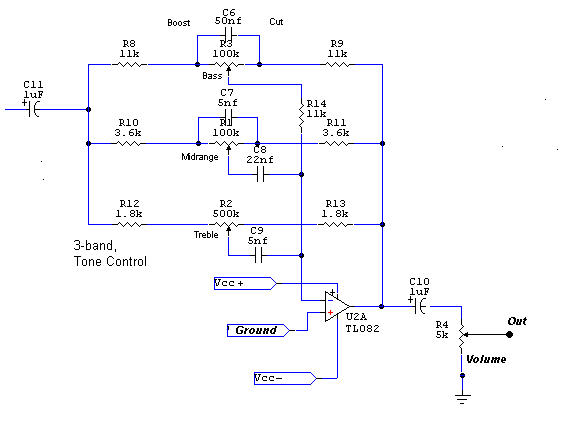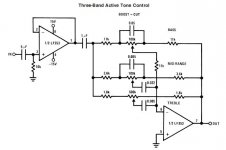Hi guys.
I'm looking for a way to control bass and treble in my diy amp.
I found some ICs that control it with a few potentiometers, like the Philips TDA 4857A, which control volum, balance, treble and bass.
Is there any other IC that I can use to control it?
I'm looking for a way to control bass and treble in my diy amp.
I found some ICs that control it with a few potentiometers, like the Philips TDA 4857A, which control volum, balance, treble and bass.
Is there any other IC that I can use to control it?
If you want a tone control you probably need to build something like this:
http://sound.westhost.com/project02.htm
I would venture that most people in this forum think that tone controls are inappropriate for Hi-Fi systems, but you may have your own specific needs.
http://sound.westhost.com/project02.htm
I would venture that most people in this forum think that tone controls are inappropriate for Hi-Fi systems, but you may have your own specific needs.
In essence, Peter Baxandall is credited for the most widespread tone control circuit using only an opamp and some passive components (including two pots). Rod Elliot uses this circuit in the project StalfoS mentions. This is your average tone control as seen on any regular stereo or car stereo for bass and trebble. Not very desirable, though.
Other, more sophisticated circuits include "graphic equalizers" (lame, as seen on bargraph EQs) and "parametric equalizers" (good but more complex, as seen on studio gear), all realizable with only one opamp per frequency range (that is to be influenced). 😉
Cheers,
Sebastian.
Other, more sophisticated circuits include "graphic equalizers" (lame, as seen on bargraph EQs) and "parametric equalizers" (good but more complex, as seen on studio gear), all realizable with only one opamp per frequency range (that is to be influenced). 😉
Cheers,
Sebastian.
sek is right: Better than a tone control is a simple graphic equaliser like this: http://www.electronic-kits-and-projects.com/kit-files/1000/1044.pdf ... 5 bands are better than 2 ... although for quality reasons, I would use a better op-amp than the old '741 ... like maybe the AD825 ...
" Channel separation, 75 dB typical " From: http://www.national.com/pf/LM/LM1036.html
An excellent choice. One might consider using two chips (as/or two single channel versions) with a well filtered power supply to get that channel seperation number up a bit ...
Make that a decent polystyrene 0.01 uF snubbing cap on pin #11 (+Vcc) and it would do just all right ... 😎
An excellent choice. One might consider using two chips (as/or two single channel versions) with a well filtered power supply to get that channel seperation number up a bit ...
Make that a decent polystyrene 0.01 uF snubbing cap on pin #11 (+Vcc) and it would do just all right ... 😎
This LM1036 looks (or sounds) very good, but it is way more expensive than the others. almost 3 times more expensive.
I don't need nothing very high-end-fancy-processor, since I already have a 10 bands x2 equalizer.
my idea is to something to control the bass/treble/balance/volume for the estereo and another controller for the subwoofer channel, baybe just gain and lowpass, like this project: http://sound.westhost.com/project48.htm
I don't need nothing very high-end-fancy-processor, since I already have a 10 bands x2 equalizer.
my idea is to something to control the bass/treble/balance/volume for the estereo and another controller for the subwoofer channel, baybe just gain and lowpass, like this project: http://sound.westhost.com/project48.htm
Re: LF353 (dual channel op-amp) and the circuit @ http://www.national.com/images/pf/LF353/00564939.pdf ... The SoCal Anon1: " ... It could double as a buffer ..."
I might also suggest leaving the first half of the chip, the unity gain stage, outta the circuit altogether, thus eliminating one of those pesky capacitors (and some of the THD) outta the audio signal = modest improvement in the sound.
If the input is directly from a well mannered pre-amp (with little or no DC offset and the gain firmly under control, higher output impedence, etc.), then there only need be a single cap in the audio signal = the single 1.0 uF non-polarized = 😀 ... in which case, the op-amp could be one of my favorites (see my avatar image) ...
Re: Costs of op-amps. If you have to ask, you can't afford to use a cheaper one ... Most single channel op-amps cost way less than US$10, dual channel op-amps less than US$12 ... speciality purpose op-amps can cost upwards of US$20 and the higher the cost, the closer they are to either obsolesence or beta development (untested in the field). The main stream op-amps are the ones that work well and cost the least ... IMOP
Any sample op-amp on this page = less than 5 US Bucks : http://www.analog.com/en/prod/0,,759_786_AD825,00.html
I might also suggest leaving the first half of the chip, the unity gain stage, outta the circuit altogether, thus eliminating one of those pesky capacitors (and some of the THD) outta the audio signal = modest improvement in the sound.
If the input is directly from a well mannered pre-amp (with little or no DC offset and the gain firmly under control, higher output impedence, etc.), then there only need be a single cap in the audio signal = the single 1.0 uF non-polarized = 😀 ... in which case, the op-amp could be one of my favorites (see my avatar image) ...
Re: Costs of op-amps. If you have to ask, you can't afford to use a cheaper one ... Most single channel op-amps cost way less than US$10, dual channel op-amps less than US$12 ... speciality purpose op-amps can cost upwards of US$20 and the higher the cost, the closer they are to either obsolesence or beta development (untested in the field). The main stream op-amps are the ones that work well and cost the least ... IMOP
Any sample op-amp on this page = less than 5 US Bucks : http://www.analog.com/en/prod/0,,759_786_AD825,00.html
Interesting as well is this dual version of my avatar image:
http://www.analog.com/Analog_Root/static/solutionsBulletins/amps9-06/images/AD8599.gif
... the thing is a lavatory grade dual channel op-amp with very, very low noise and it is US$4.25 in quantity !!! ... samples slightly higher

http://www.analog.com/Analog_Root/static/solutionsBulletins/amps9-06/images/AD8599.gif
... the thing is a lavatory grade dual channel op-amp with very, very low noise and it is US$4.25 in quantity !!! ... samples slightly higher

FastEddy said:... the thing is a lavatory grade dual channel op-amp
[/B]
is it really that bad 😀
" ... lavatory grade ..." My poor attempt at levity ... read as: laboratory grade ...
I have not actually built anything with the '8599 dual op-amp yet ... just impressed with that noise spec / input voltage ... I mean check it out:
Low noise: 1 nV/√Hz at 1kHz ... holy cow !!!
Low distortion: −105 dB THD @ 20 kHz ... very usable
<80 nV p-p input noise, 0.1 Hz to 10 Hz ... about as good as it gets in an active low pass crossover for subwoofers = that's nano-volts !
Slew rate: 16 V/μs ... very decent
Wide bandwidth: 10 MHz ... typical of the breed.
😀
I have not actually built anything with the '8599 dual op-amp yet ... just impressed with that noise spec / input voltage ... I mean check it out:
Low noise: 1 nV/√Hz at 1kHz ... holy cow !!!
Low distortion: −105 dB THD @ 20 kHz ... very usable
<80 nV p-p input noise, 0.1 Hz to 10 Hz ... about as good as it gets in an active low pass crossover for subwoofers = that's nano-volts !
Slew rate: 16 V/μs ... very decent
Wide bandwidth: 10 MHz ... typical of the breed.
😀
it's all relative
Great info as I'm about to add a pre to my GC and was considering a tone control.
Quote from Denis.BR : 'This LM1036 looks (or sounds) very good, but it is way more expensive than the others. almost 3 times more expensive.'
Yes, and beer is way more expensive than horse pi$$. Drink Up!
Great info as I'm about to add a pre to my GC and was considering a tone control.
Quote from Denis.BR : 'This LM1036 looks (or sounds) very good, but it is way more expensive than the others. almost 3 times more expensive.'
Yes, and beer is way more expensive than horse pi$$. Drink Up!
Hi guys, just a brief 'pip' in here - I have tried the AD8599 and I have absolutely no need to try try any of the LMxxxx's on that background. Absolutely amazing - it's very unlikely to leave it's current inplementation in my Marantz multimedia centre...
Kind regards
a1greatdane😎
Kind regards
a1greatdane😎
" ... 'This LM1036 looks (or sounds) very good, but it is way more expensive than the others. almost 3 times more expensive.' ..."
Speaking of "relative" ... How anyone can complain about the costs of these chips in the 21st Century is way beyond my humble opinions ... Come on, guys. Even at US$20 bucks a throw, this stuff is CHEAP.
😱
Speaking of "relative" ... How anyone can complain about the costs of these chips in the 21st Century is way beyond my humble opinions ... Come on, guys. Even at US$20 bucks a throw, this stuff is CHEAP.
😱

I have used this circuit quite a few times and had very good results....

it would be good to put an Inverting unity gain buffer before the circuit so you maintain the correct Phaze/Polarity....

it would be good to put an Inverting unity gain buffer before the circuit so you maintain the correct Phaze/Polarity....
" ... it would be good to put an Inverting unity gain buffer before the circuit ..."
Maybe 'tween the DC blocking cap (C11) and the circuit? ... Then you could use a dual channel version of the TL082 (U2A) ... U2B ?
I might also suggest increasing the size of the I/O input / output Caps (U10 & U11) to > 2.2 uF for a bit better low end response ... No?
Maybe 'tween the DC blocking cap (C11) and the circuit? ... Then you could use a dual channel version of the TL082 (U2A) ... U2B ?

I might also suggest increasing the size of the I/O input / output Caps (U10 & U11) to > 2.2 uF for a bit better low end response ... No?
" ... Or remove the caps if you are sure that there won't be any DC offset problem. ... "
You might be right here, except there will be a varying output voltage / impedance question as when bass or treble or mid offset from 0db gain or loss ... leading to possible offset from the op-amps to whatever this circuit it is hooked to ... I believe I would keep the output DC blocking cap, but the input cap (C11) might not be needed ...
( Note that the op-amp(s) is not rigged with any DC "bias" offset control(s) ... which might or might not have a downstream effect ... 😕 )
The circuit is a good one, using a tried and true methodology ...
You might be right here, except there will be a varying output voltage / impedance question as when bass or treble or mid offset from 0db gain or loss ... leading to possible offset from the op-amps to whatever this circuit it is hooked to ... I believe I would keep the output DC blocking cap, but the input cap (C11) might not be needed ...
( Note that the op-amp(s) is not rigged with any DC "bias" offset control(s) ... which might or might not have a downstream effect ... 😕 )
The circuit is a good one, using a tried and true methodology ...
- Status
- Not open for further replies.
- Home
- Amplifiers
- Chip Amps
- Bass and treble control...how?
